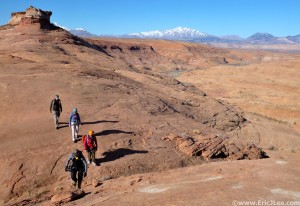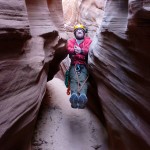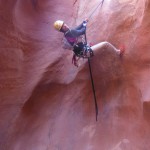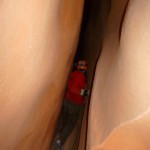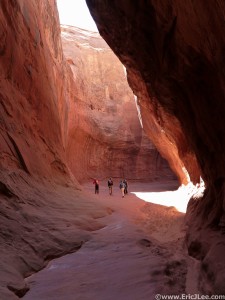Sunday March 24th found us with yet another early pre-dawn start, packing up the tents as the sun’s morning glow illuminated the San Rafael Swell. Today it was off to Leprechaun Canyon south of Hanksville, UT. The three forks of Leprechaun canyon are in a region of Utah known as North Wash, known for its very narrow slot canyons (less than 2ft), so to the point of being extremely dangerous. We parked ourselves at the Sandthrax campground and started our approach hike up the slickrock, quickly gaining elevation all the way to the rimrock high above. We were treated with some sweeping views of the Henry Mts to the South and the deep narrow canyons of North Wash on all sides. We quickly picked up a trail and strolled our way to the head of the East Fork of Leprechaun canyon, the easiest of the three.
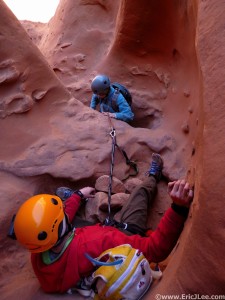
Ben giving Amanda a deadman belay at the second obstacle. Note the pile of rocks is the main anchor.
We skipped the first rappel, walking around and exploring the short slot from below, and proceeded into the meat of the canyon, which immediately started off with a 3 tiered drop through a series of potholes. We set up a rappel off a deadman anchor for several of our party, while Basit and I downclimbed. For those unfamiliar with the terminology, a deadman anchor consists of a weight, usually either a pile of rocks or a person, that one secures the rope to. These objects are most often not attached or secured to the canyon itself, simply relying on weight and gravity to hold them in place, sounds fun huh? As we continued to squeeze down canyon we encountered some impressive narrows, stretches of up half a mile at a time where the canyon walls rarely exceeded
2ft wide. We stemmed, squeezed and chimneyed our way down canyon, setting up a few short rappels along the way, though Basit, Ben and I were able to downclimb all the obstacles without the aid of a rope.
Near the confluence with the Middle fork the canyon walls finally opened up, just before the final drop, a series of three potholes with a 15ft vertical drop at the end. We opted to set up a handline for this short drop, and simply went hand over hand down the webbing. Once at the confluence we dropped our packs for a little bit of exploration up the Middle Fork into a slot known as Belfast Boulevard, so narrow that we had to walk sideways and couldn’t pass one another once we’d started in. After a little playing around we shouldered the gear and headed down canyon through a dark tunnel which brought us to a large subway section with overhanging sand stone walls towering above a smooth and flat canyon floor. It’s one of those places that reminds you of how small you truly are.
We strolled down canyon, soaking in the grandeur of our setting and the warm sun. We soon hit the road and made our way back at the Sandthrax campground, only 4.5hours after we’d started. The East Fork of Leprechaun offers the canyoneer a fun adventure, with lots of scrambling, stemming, downclimbing and chimneying. All of the major obstacles can be downclimbed without a harness/rope by a strong canyoneer, though assistance with handlines and foot spotting is definitely helpful. The Middle Fork and West Fork are much more difficult, so only proceed into those with an experienced crew and all the proper gear.
At the cars we opted to enjoy a little down time, devouring much of our food and stretching our legs before the long drive home. We finally bid Ben and Amanda farewell, as they were headed to Cedar Mesa for the next five days, and hit the road for the long 7.5hour drive back to Boulder, CO. What a weekend, the drive had been well worth all the adventure and good times. There will definitely be more slot canyons in my future, though hopefully I won’t have to wait too long.

